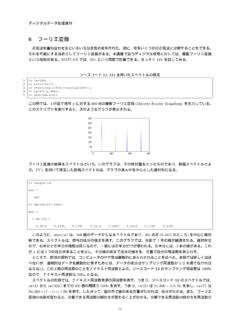Transcription of Need for palliative care Hospice, Palliative Care and SLP ...
1 2/4/2013 1 hospice , Palliative care and SLP management of dysphagia Nancy B. Swigert, , CCC-SLP, BRS-S Director Speech-Language Pathology & Respiratory care Baptist Health-Lexington Nancy B. Swigert, , CCC-SLP, BRS-S 1 Need for Palliative care Strong correlation between aging and chronic illness Need to provide symptom and disease management for hospitalized patients not facing death within prescribed time Not eligible for hospice services Ross, Mathis & Brockopp (2008) Nancy B. Swigert, , CCC-SLP, BRS-S 2 Cost of managing chronic illness Management of chronic illness that is not life-threatening accounts for approximately 75% of available health care resources in Institute of Medicine (2001) Rice & Fineman (2004) Nancy B. Swigert, , CCC-SLP, BRS-S 3 Palliative or hospice ? Traditionally Palliative care and hospice care are provided to individuals diagnosed as terminally ill More recently, Palliative services are available to patients with chronic conditions who do not meet qualifications for hospice Nancy B.
2 Swigert, , CCC-SLP, BRS-S 4 Needs of patients with chronic conditions Management of symptoms: Pain Nausea Fatigue Psychosocial issues Spiritual issues Nancy B. Swigert, , CCC-SLP, BRS-S 5 Challenges to establishing a Palliative care program Shift in philosophy of the staff providing the care Change from focus on cure to focus on management Fear that the program will drain resources White, Stover, Cassel, Smith (2006) Nancy B. Swigert, , CCC-SLP, BRS-S 6 2/4/2013 2 The development of CBH Palliative care Program Goals of the program to develop a system of care that would address: Unique needs of patients with symptomatic illness regardless of diagnosis or place on the illness trajectory Patients needs in context of social system Holistic care including curative measures and management of symptoms Ross, Mathis and Brockopp 2008 Nancy B.
3 Swigert, , CCC-SLP, BRS-S 7 What is the role of rehabilitation in hospice and Palliative care ? With disease progression, patients have: High levels of functional loss Dependency for activities of daily living Mobility dysfunction Cheville (2009) Santiago-Palma, Payne (2001) Information from: Rehabilitation of the hospice and Palliative care Patient. Javier, & Montagnini, (2011). Journal of Palliative Medicine Vol. 14; No. 5. 638-648 Nancy B. Swigert, , CCC-SLP, BRS-S 8 Why do hospice & Palliative care patients need rehabilitation? Multiple factors contribute: De-conditioning Fatigue Complications from therapies Under-nutrition Neurologic and musculoskeletal problems Pain Bowel and bladder dysfunction Thrombo-embolic disease Depression Co-existing co-morbidities Multiple sources Nancy B. Swigert, , CCC-SLP, BRS-S 9 Do hospice & Palliative care patients want rehabilitation?
4 Most hospice patients express desire to remain physically independent during the course of their disease Wallston, Burger, Smith & Baugher 1988 Ebel, Langer (1993) Mayer (1975) Nancy B. Swigert, , CCC-SLP, BRS-S 10 Benefits of Palliative rehabilitation Improved quality of life Improved mobility Better control of pain and other symptoms Improved mood Gains in motor and cognitive function Shorter lengths of stay Various sources Nancy B. Swigert, , CCC-SLP, BRS-S 11 Role of the SLP (Pollens 2004) Provide consultation to patients, families and the care team re: Communication Cognition Swallowing Develop strategies in area of communication skills to support the patient s role in decision making, maintain social closeness and assist patient in achieving fulfillment of end-of-life goals Nancy B. Swigert, , CCC-SLP, BRS-S 12 2/4/2013 3 Role of the SLP To assist in optimizing function related to dysphagia symptoms to improve patient comfort and satisfaction Promote positive feeding interactions with family members Communicate with the care team related to overall care of the patient Nancy B.
5 Swigert, , CCC-SLP, BRS-S 13 Differences in Palliative and hospice How does the SLP s approach differ in Palliative vs. hospice ? Use of instrumentals Facilitations vs compensations How conservative we are with recommendations Nancy B. Swigert, , CCC-SLP, BRS-S 14 What resources can the SLP use when working with patients and families? ASHA Code of Ethics Principles of Biomedical Ethics Case law Nancy B. Swigert, , CCC-SLP, BRS-S 15 ASHA Code of Ethics Principle of Ethics I: Individuals shall honor their responsibility to hold paramount the welfare of persons they serve professionally Rule D: Individuals shall fully inform the persons they serve of the nature and possible effects of services rendered and products dispensed Principle of Ethics I Rule F: Individuals shall not guarantee the results of any treatment or procedure, directly or by implication; however, they may make a reasonable statement of prognosis Nancy B.
6 Swigert, , CCC-SLP, BRS-S 16 Autonomy Respect for Autonomy Patients have right to make independent choices about their care Free from controlling influences and have capacity to make independent decisions If the patient can t make independent choice, involve surrogate decision makers Nancy B. Swigert, , CCC-SLP, BRS-S 17 Non-maleficence Above all, do no harm Do not cause harm or impose the risk of harm Closely tied to the principle of beneficence Provide positive benefits to patients Action done for the benefit of others Implies an obligation to help others Paternalism sometimes necessary in order to do good Paternalism is in conflict with autonomy Nancy B. Swigert, , CCC-SLP, BRS-S 18 2/4/2013 4 Patient rights Right to predetermine medical treatment limits Right to discontinue or refuse treatment Right to refuse to follow swallowing safety recommendations Nancy B.
7 Swigert, , CCC-SLP, BRS-S 19 SLP ethical responsibilities Determination of efficacious treatment approaches Responsibility to educate/explain potential risks and outcomes Responsibility to accept patient/family decisions Responsibility to advocate for treatment or no treatment Responsibility to continue or discontinue treatment Nancy B. Swigert, , CCC-SLP, BRS-S 20 History of PEG Ponsky adapted it in the early 1980s for use with adults Used with stroke patients initially Use quickly spread to patients with terminal cancer and elderly with dementia Device generally low cost ($200-$600) Short recovery time meant patients could be discharged quickly Nancy B. Swigert, , CCC-SLP, BRS-S 21 Increase in PEG use Embraced by nursing homes b/c it was a quick way to feed patients who couldn t feed themselves Question: Is it easier for the physician to order a PEG placed than to have a difficult conversation with the family?
8 Nancy B. Swigert, , CCC-SLP, BRS-S 22 PEGs in nursing homes In 1999, nearly 34% of residents with severe dementia in nursing homes were living with PEG Mitchell, DL, Tetroe, JM. 2000 A recent five-state survey found that 11% of persons dying with dementia had a feeding tube Teno, Mitchell, Kuo et al (2011) Nancy B. Swigert, , CCC-SLP, BRS-S 23 PEGs and economics Medicare considers PEGs to be skilled nursing Hand feeding is not skilled Nursing homes get more money for patients with PEG and they also do not have the cost of paying someone to feed CNA making $8/hr can hand-feed perhaps 2 patients in an hour Can hook up 10 feeding tubes in same amount of time Tube-fed residents in nursing homes generate a higher daily reimbursement rate from Medicaid, but require less expensive care Mitchell, Buchanan, Littlehale & Hamel 2003 Nancy B.
9 Swigert, , CCC-SLP, BRS-S 24 2/4/2013 5 Advance directive Legal, written statement of medical choices or the way the patient wants medical choices to be determined Written prior to need for such decisions Goes into effect when patient can no longer decide for him/herself or can no longer tell others of decision Cannot be required to have advance directive Nancy B. Swigert, , CCC-SLP, BRS-S 25 Living wills may include: Directions that life-prolonging treatment not be provided, or once started, that such treatment be stopped Directions that food (nutrition) and water (hydration) not be provided through artificial means like tubes, or once started, that they be stopped A choice of one or more persons to act as your surrogate and make decisions for you Nancy B. Swigert, , CCC-SLP, BRS-S 26 Healthcare surrogate/Durable Power of Attorney Person you appoint in your living will or in another written document to make medical decisions for you if you are not able to speak for yourself Advance directive that lets you name someone (attorney-in-fact) to make medical decisions for you if you re unable to speak for yourself Similar to healthcare surrogate, but may also give attorney-in-fact power to make decisions about personal and financial affairs Nancy B.
10 Swigert, , CCC-SLP, BRS-S 27 Why those arguments don t work Artificial nutrition and hydration = medical procedure Virtually every reported appellate case has rejected these objections Nutrition and hydration may be forgone according to same standards as any other medical treatment AMA classifies artificial nutrition and hydration as life-prolonging medical treatment Nancy B. Swigert, , CCC-SLP, BRS-S 28 Medicare and Medicaid requirements For long-term care facilities - recognize that competent residents have unqualified right to refuse treatment, including artificial nutrition and hydration when state law permits Cause of death is patient s inability to eat, brought about by disease or injury, and cannot be characterized as starvation Nancy B. Swigert, , CCC-SLP, BRS-S 29 Artificial nutrition and hydration carries own set of risks, discomforts and drawbacks Courts view PEG as highly intrusive NG can contribute to progression of disease Persistent vegetative state -- continuing artificial nutrition and hydration denies dignity Nancy B.














